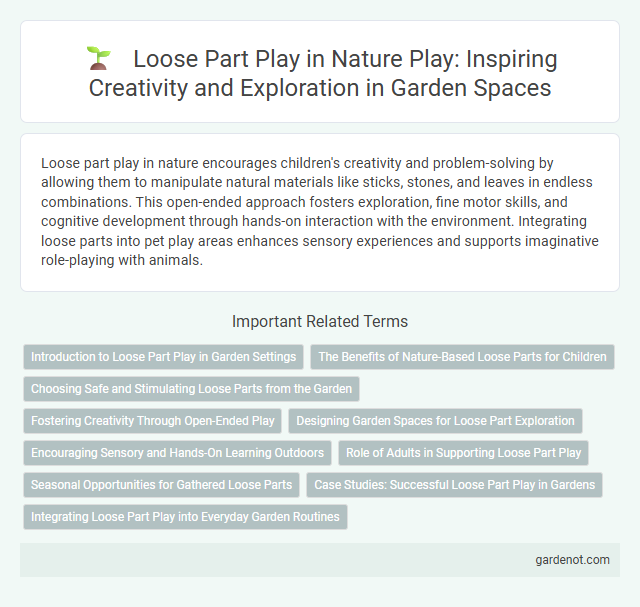Loose part play in nature encourages children's creativity and problem-solving by allowing them to manipulate natural materials like sticks, stones, and leaves in endless combinations. This open-ended approach fosters exploration, fine motor skills, and cognitive development through hands-on interaction with the environment. Integrating loose parts into pet play areas enhances sensory experiences and supports imaginative role-playing with animals.
Introduction to Loose Part Play in Garden Settings
Loose part play in garden settings encourages children to engage with natural materials such as sticks, stones, leaves, and soil, fostering creativity and problem-solving skills. This play method supports sensory development and promotes imaginative exploration by allowing children to manipulate and combine diverse elements freely. Integrating loose parts in outdoor environments enhances physical activity and nurtures a deeper connection with nature.
The Benefits of Nature-Based Loose Parts for Children
Nature-based loose parts such as sticks, stones, leaves, and pinecones promote creativity, problem-solving, and sensory exploration in children. These open-ended materials encourage imaginative play and physical activity, supporting cognitive and motor skill development. Exposure to natural elements through loose parts also fosters environmental awareness and emotional well-being.
Choosing Safe and Stimulating Loose Parts from the Garden
Selecting safe and stimulating loose parts from the garden enhances children's nature play by promoting creativity and sensory exploration. Natural items such as smooth stones, pinecones, leaves, and sticks free from sharp edges or toxic substances encourage imaginative play while minimizing risks. Ensuring loose parts are clean, non-allergenic, and appropriately sized supports a secure and engaging outdoor learning environment.
Fostering Creativity Through Open-Ended Play
Loose parts play enhances children's creativity by providing open-ended materials like sticks, stones, fabric, and shells that encourage imaginative exploration and problem-solving. Engaging with these versatile natural and man-made elements allows children to construct, deconstruct, and reconstruct their environments, fostering cognitive flexibility and innovation. This type of play supports developmental skills such as critical thinking, collaboration, and emotional expression, all vital for holistic growth.
Designing Garden Spaces for Loose Part Exploration
Designing garden spaces for loose part exploration enhances children's creativity and problem-solving skills by providing diverse natural materials such as sticks, stones, leaves, and pinecones. Incorporating movable elements like logs, crates, and fabric encourages open-ended play and sensory engagement in outdoor environments. These thoughtfully crafted spaces promote physical activity, social interaction, and ecological awareness through hands-on discovery and imaginative construction.
Encouraging Sensory and Hands-On Learning Outdoors
Loose part play in nature encourages sensory and hands-on learning by allowing children to interact with varied natural materials like sticks, leaves, stones, and pinecones. This unstructured play promotes creativity, problem-solving, and fine motor skills as children manipulate and combine loose parts to explore textures, shapes, and sounds. Engaging with natural elements outdoors enhances experiential learning and supports cognitive development through tactile and sensory experiences.
Role of Adults in Supporting Loose Part Play
Adults play a crucial role in facilitating loose part play by providing diverse, natural materials that stimulate creativity and problem-solving skills in children. They observe without directing, allowing children to explore freely while ensuring a safe and supportive environment that encourages experimentation and collaboration. By asking open-ended questions and offering gentle guidance, adults enhance the learning experience and empower children to make independent choices during play.
Seasonal Opportunities for Gathered Loose Parts
Loose part play encourages children to use natural materials like leaves, pinecones, and acorns collected during different seasons to enhance creativity and sensory exploration. Seasonal opportunities allow for diverse textures, colors, and sizes, promoting cognitive development and environmental awareness. Gathering loose parts throughout the year supports dynamic outdoor learning and encourages sustainable interaction with nature.
Case Studies: Successful Loose Part Play in Gardens
Case studies of successful loose part play in gardens highlight improvements in children's creativity, problem-solving skills, and social interaction. Gardens equipped with natural loose parts like sticks, stones, and fabric scraps foster exploratory learning and physical activity. Evaluations report increased engagement and environmental awareness among participants, demonstrating the effectiveness of incorporating loose parts in outdoor play spaces.
Integrating Loose Part Play into Everyday Garden Routines
Integrating loose part play into everyday garden routines encourages creativity and sensory exploration by incorporating natural materials like sticks, stones, and leaves into children's activities. This approach promotes problem-solving skills and fine motor development as kids construct, experiment, and engage with varied textures and shapes found in the garden. Regularly offering diverse loose parts within the garden environment transforms routine tasks into dynamic learning opportunities, fostering a deeper connection with nature.
Loose part play Infographic

 gardenot.com
gardenot.com